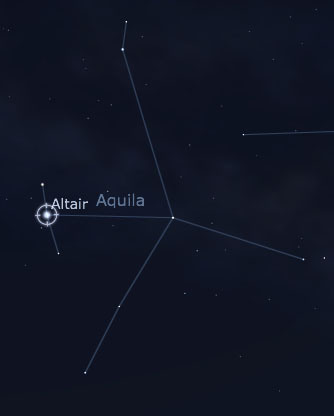Altair
First magnitude Altair, the 13th brightest star in the sky and the Alpha star of Aquila “The Eagle” is also part of the “Summer Triangle”. Viewed from the northern hemisphere, Altair forms the bottom point of the “Summer Triangle”, with the other two points marked by Vega in Lyra and Deneb in Cygnus.
Altair’s name derives from the Arabic for “Flying Eagle”. Altair is flanked by two starts, Alshain and Tarazed, that really does make the constellation Aquila look like a bird with outstretched wings. The three stars also gives the appearance of a tail of an airplane that is slowly flying across the nights sky.
Altair is remarkably distorted bulging by 22% at its equator. This distortion is due to its rapid rotation. It spins around in just 6.5 hours far less than the 26 days it take our Sun to rotate. Altair’s rotation causes its equator to be less dense and cooler than its poles.
It is also interesting to note that Altair is moving across the sky against a background of distant stars more quickly than most and will displace itself by as much as a degree in 5000 years.

.
Altair Overview:
- Constellation Aquila
- Alpha (α) 19h51m, +08°52′
- Magnitude 0.77
- Luminosity 10.6 Suns
- Spectral Type A7V
- Distance 16.7 light years
Aquila Constellation … The Eagle
Lying directly north of Sagittarius, the constellation of the Eagle is easily found on norther summer nights thanks to the brilliance of Altair. According to Greek and Roman mythology, the eagle was the bird of Zeus which carried thunderbolts towards the enemies of the god. Other stories say Zeus transformed into an eagle to abduct Ganymede, represented in neighboring Aquarius.
As a side note … when you find the constellation of Aquila in the nights sky you are looking towards the spiral arm of our Milky Way galaxy. Near Aquila is the constellation Sagittarius which points you almost directly at the Galactic Center or rotational center of the Milky Way.
Astronomy 101
